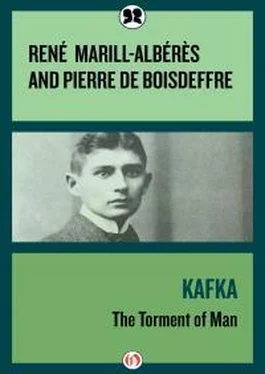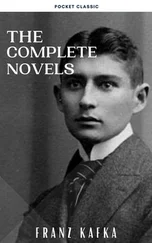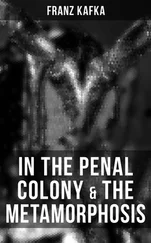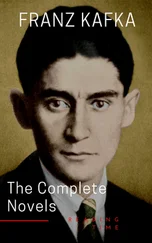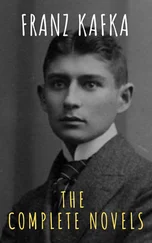Kafka wrote “objective novels” before the term was coined! He refuses to give us the impression conveyed to us by things and gives us instead the thing itself—strange, weird, unclean.
In our synagogue lives an animal about the size of a marten. He is frequently seen, but at a distance of about two meters; he allows no one to come closer. His color is light greenish-blue; no one has touched his fur. Thus nothing can be said about him, and one might even state that his true color is unknown. 4
Here the object is real by virtue of the very distance that separates it from the narrator; the information obtainable about it is at once precise and limited.
It is through dry, minute details that Kafka creates the impression of reality within unreality. The world evoked by him is often improbable, but it exists. It exists because we are never sure that we can explore it, because we feel that it is more luxuriant than any world that could possibly be described. In each of his works, moreover, Kafka makes us feel the invisible presence of an infinite number of characters—of whom some must be sacrificed.
This attentiveness to the accessory characters that I meet in novels, plays, etc. This feeling of solidarity that I experience then with respect to them! In The Maidens of Bischofsberg … it is a matter of two seamstresses who are making the wearing apparel of the only married woman in the play. How do they fare? Where do these girls live? What have they done to deprive themselves of the right to appear in the course of the play? … 5
Kafka’s art of narration resides in this concern for invisible dressmakers. The truth of his style and imagination lies in his diligence in trying to follow conscientiously every possible trail. He deplores the fact that “in writing a story” he does not really “ have the time to reach out in all directions , as one should.” 6Thus the world becomes a labyrinth. A world which is more and more phantasmal or symbolic, yet more and more real. The sadistic act of capital execution in “In the Penal Colony,” for example, “draws its reality entirely from the administrative and technical seriousness with which the officer describes the horrible Machine.”
Along with a total mastery of the art of cruel or absurd narration, Kafka also acquired, between 1912 and 1914, the fundamental themes that were to be expressed in allegories in his masterworks. At this stage, a narrative is for him a combination of events that lead nowhere. Whereas a story ordinarily opens up new perspectives and the possibility of new adventures, the Kafkan narrative closes these perspectives. It functions like the Torture Machine described in “In the Penal Colony,” engraving in the flesh a sentence which the condemned man is unable to read. The outcome is inevitable: just as repetition of the bloody imprinting entails death, repetition of the nonsensical details of everything that happens also leads to death. This is the principle of tragedy, in which everything is sensed in advance. But the Kafkan narrative is a gray tragedy which lacks even an illusion, a tragedy which is not enacted because the fatality and futility of human effort is felt from the outset . Man senses from the beginning that he is losing his struggle, and only the monotony of the event—completely futile, moreover, because the outcome is predetermined and offers no hope—can create an illusion of drama and life in a world already dead.
Kafka takes up his themes and buries himself in them as an animal buries itself in its hole. His fascination often is attributable to his art of enclosing himself and his narrative in a bunker—his art of withdrawing into himself and creating a wall between himself and the outside world. For before he expresses man’s loneliness in the face of an empty heaven, he expresses man’s inner loneliness. In this sense “The Burrow” is representative of the structure and inspiration of a number of his stories. For page after page we see the designs of a lonely animal that lives under the earth, digs passageways, constructs an underground citadel: “I have completed the construction of my burrow, and it seems to have turned out well.” In the process of laying out the inside of his dwelling, this creature seems to confuse himself with it, with the plans which he is always making for its completion, and with the pleasure which awareness of its existence causes him to experience.
…Then it seems to me that I am not in the presence of my house but in the presence of myself, a sleeping self, and that I have the good fortune to be in a deep sleep and at the same time to watch over myself like a sentry.
Here loneliness is withdrawal into oneself, alienation of self in a limited pseudo-self created for oneself. In much the same way the insignificant employee in “Bachelor’s Misery” becomes entrenched and isolated in the minute organization of his life, and “A Hunger Artist”—a man who exhibits himself in a sealed cage at fairs—withdraws into himself and gives himself over exclusively to fasting, to the pleasure of fasting, to the absurd ideal of fasting, until he dies the death of an insect which recalls the death of Gregor Samsa.
Thus there are two forms of loneliness: the silence of the world and the loneliness of withdrawal—the temptation which a human being feels to create his own prison inside himself or inside a projection of himself—an employment as absurd as the burrow fashioned by the subterranean creature. Kafka knew the intoxication of this temptation and was often overcome by it. In the short stories—some brief sketches, some fragments—published in 1919 in the collection A Country Doctor , in 1924 A Hunger Artist , and in 1931 in The Great Wall of China and Other Stories (a collection edited by Max Brod) one story out of three owes its magic spell to Kafka’s ability to enclose himself vertiginously, from the very outset, in a cloistered, uneasy world and to make this world hauntingly real: “Everything falls on my shoulders. In the anteroom two girls, the typewriters, and the ledgers. In my office, the table that I occupy, the conference table, the Safe, a large English chair, the telephone.…” 7Each human being takes refuge in his own meticulous labyrinth. That Kafka’s world is a barren world for man has been observed repeatedly, but not enough attention has been paid to the fact that, even before we are overwhelmed by the incoherence and silence of the universe, the primordial truth is that each individual is a prison. Men construct around themselves, in order to hide themselves, the gigantic walls of a molehill: “Hiding places are numberless, deliverance is unique; but there are as many possibilities of deliverance as there are hiding places.” 8In many of the stories which he started to write, in the opening lines of many stories (even fragments consisting of a few lines recorded in his Notebooks ) we find the first passageway of a burrow. Kafka is generally inspired by nothing more than a few sentences that create the closed universe of a being imprisoned in himself.
I am a valet but an unemployed valet. I am shy, not forward. I don’t even dare to put myself on an equal footing with others, but this is perhaps only one of the reasons for the idleness which they force on me. 9
This beginning can subsequently be developed in minute detail: no exit is to be found. Each man is attached to his own little dwelling, hutch, burrow, routine, possession; but the fastidious mania that possesses him transforms this small enchanted world into a frightening labyrinth. Kafka achieves something resembling a universal “metaphysical” resonance because he plunges each time into a singular existence: “Each human being is singular and called upon to act by virtue of his singularity, so he must take a liking to it.” 10But Kafka does take a liking to his singularity. None of his heroes is charged with representing man in general, but each of them is a strange, eccentric being. The Castle would be meaningless if K. were not a Land-Surveyor in a world that cannot be measured.
Читать дальше
